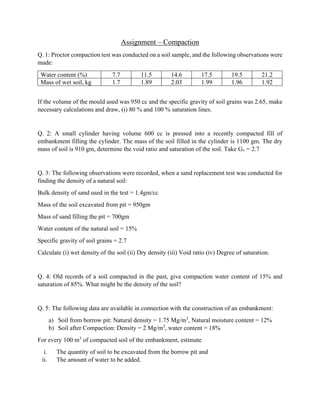
Geotechnical Engineering-I [Lec #14A: Soil Compaction - Problem Sheet]
- 1. Assignment – Compaction Q. 1: Proctor compaction test was conducted on a soil sample, and the following observations were made: Water content (%) 7.7 11.5 14.6 17.5 19.5 21.2 Mass of wet soil, kg 1.7 1.89 2.03 1.99 1.96 1.92 If the volume of the mould used was 950 cc and the specific gravity of soil grains was 2.65, make necessary calculations and draw, (i) 80 % and 100 % saturation lines. Q. 2: A small cylinder having volume 600 cc is pressed into a recently compacted fill of embankment filling the cylinder. The mass of the soil filled in the cylinder is 1100 gm. The dry mass of soil is 910 gm, determine the void ratio and saturation of the soil. Take Gs = 2.7 Q. 3: The following observations were recorded, when a sand replacement test was conducted for finding the density of a natural soil: Bulk density of sand used in the test = 1.4gm/cc Mass of the soil excavated from pit = 950gm Mass of sand filling the pit = 700gm Water content of the natural soil = 15% Specific gravity of soil grains = 2.7 Calculate (i) wet density of the soil (ii) Dry density (iii) Void ratio (iv) Degree of saturation. Q. 4: Old records of a soil compacted in the past, give compaction water content of 15% and saturation of 85%. What might be the density of the soil? Q. 5: The following data are available in connection with the construction of an embankment: a) Soil from borrow pit: Natural density = 1.75 Mg/m3 , Natural moisture content = 12% b) Soil after Compaction: Density = 2 Mg/m3 , water content = 18% For every 100 m3 of compacted soil of the embankment, estimate i. The quantity of soil to be excavated from the borrow pit and ii. The amount of water to be added.
- 2. Q. 6: A field density test was conducted by core cutter method. The observation data is given below: Mass of empty core cutter = 2280gm Mass of soil + core cutter = 4950gm Inter dimensions of core cutter: 9.10 cm dia and 17.8 cm height Mass of sample for moisture content determination = 54gm Mass of oven dry sample = 50gm Specific gravity of soil grains = 2.7 Determine: (i) dry density (ii) void ratio (iii) degree of saturation Q. 7: If a sample is saturated at a water content of 30%, what is its density, Assume Gs = 2.7 Q. 8: A soil in the borrow pit is at a dry density of 1.7 Mg/m3 with water content of 12%. If a soil mass of 2000 cubic meter volume is excavated from it and compacted in an embankment with a porosity ratio of 0.32, calculate the volume of the embankment, which can be constructed out of this material. Assume Gs = 2.67 Q. 9: A proposed earth embankment is required to be compacted to 95% of Standard Proctor dry density. Tests on the material to be used for the embankment gives maximum dry density of 1.98 Mg/m3 at optimum content of 12%. The borrow pit material in its natural condition has a void ratio of o.6. If Gs for borrow pit material is 2.7, what is the minimum volume of borrow material required to make 100 cu. m of acceptable compacted fill. Q. 10: An express highway is going to be constructed on a 3 m high embankment. The top width of this embankment is going to be 40 m with a side slope of 1V:2.5H. It is proposed that the borrow material for this embankment be excavated from ditches on both sides of the highway. It has been found out through geotechnical investigations that in-situ material has a bulk density of 110 lbs/ft3 and moisture content of 10%. The compacted density of the embankment is to be 120 lbs/ft3 with moisture content of 14%. Calculate the depth of 40 m wide ditches (on both sides of the embankment) which would furnish the required quantity of borrow material. Assume Gs = 2.68. Q. 11: A sand replacement test was performed to determine the in-situ density of fill comprising cohesion less soil. The weight of the soil excavated from the pit was 2100 gm. The volume of the pit determined by filling the sand in the pit was 1000 cc. The excavated soil was oven dried and
- 3. its weigh was found to be 1900 gm. Using this dry soil a vessel of volume 400 cc was filled with soil in its loosest state. The weight of loose soil in the vessel was measured to be 750 gm. Then the vessel filled with soil was placed on a vibratory table to vibrate it according to the standard method. The volume of the compacted soil in the vessel after vibration was found to be 300 cc. Determine the relative density of the fill assuming Gs = 2.70. Q. 12: The natural moisture content of a borrow material is 8%. Assuming 3000gm of moist soil for a standard compaction test, how much water is to be added to bring the sample to 11, 15, and 20% water contant?